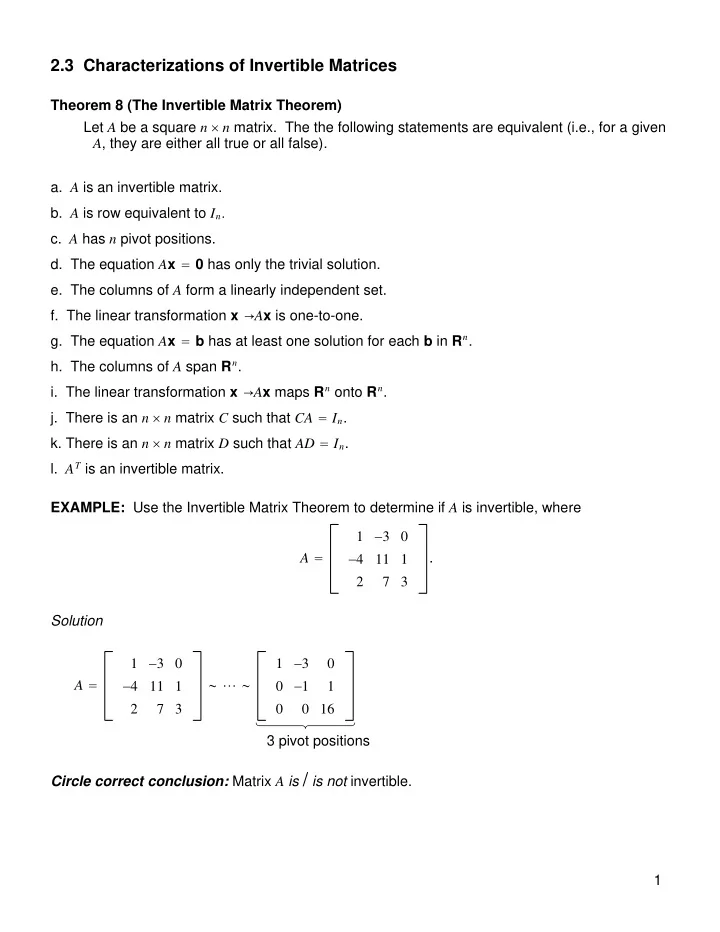

2.3 Characterizations of Invertible Matrices Theorem 8 (The Invertible Matrix Theorem) Let A be a square n × n matrix. The the following statements are equivalent (i.e., for a given A , they are either all true or all false). a. A is an invertible matrix. b. A is row equivalent to I n . c. A has n pivot positions. d. The equation A x = 0 has only the trivial solution. e. The columns of A form a linearly independent set. f. The linear transformation x → A x is one-to-one. g. The equation A x = b has at least one solution for each b in R n . h. The columns of A span R n . i. The linear transformation x → A x maps R n onto R n . j. There is an n × n matrix C such that CA = I n . k. There is an n × n matrix D such that AD = I n . l. A T is an invertible matrix. EXAMPLE: Use the Invertible Matrix Theorem to determine if A is invertible, where 1 − 3 0 . A = − 4 11 1 2 7 3 Solution 1 − 3 0 1 − 3 0 A = − 4 11 1 0 − 1 1 ∼ ⋯ ∼ 2 7 3 0 0 16 3 pivot positions Circle correct conclusion: Matrix A is / is not invertible. 1
2 Proof: The theorem is proven using this scheme: a. ⇒ j. Definition of “invertible.” j. ⇒ d. Exercise 23, Section 2.1 d. ⇒ e. Box, p. 66 e. ⇒ f. Theorem 12, Section 1.9 f. ⇒ d. Theorem 11, Section 1.9 d. ⇒ c. Exercise 23, Section 2.2 c. ⇒ b. Exercise 23, Section 2.2 b. ⇒ a. Exercise 23, Section 2.2 a. ⇒ k. Definition of “invertible.” k. ⇒ g. Exercise 24, Section 2.2 g. ⇒ h. Theorem 4, Section 1.4 h. ⇒ i. Theorem 12, Section 1.9 i. ⇒ g. Definition of “onto.” g. ⇒ a. Exercise 24, Section 2.2 a. ⇒ l. Theorem 6, Section 2.2 l. ⇒ a. Theorem 6, Section 2.2
EXAMPLE: Suppose H is a 5 × 5 matrix and suppose there is a vector v in R 5 which is not a linear combination of the columns of H . What can you say about the number of solutions to H x = 0 ? Since v in R 5 is not a linear combination of the Solution columns of H , the columns of H do not ___________ R 5 . So by the Invertible Matrix Theorem, H x = 0 has _________________________________________. Invertible Linear Transformations For an invertible matrix A , A − 1 A x = x for all x in R n and AA − 1 x = x for all x in R n . A linear transformation T : R n → R n is said to be invertible if there exists a function S : R n → R n such that S T x = x for all x in R n and T S x = x for all x in R n . Theorem 9 Let T : R n → R n be a linear transformation and let A be the standard matrix for T . Then T is invertible if and only if A is an invertible matrix. In that case, the linear transformation S given by S x = A − 1 x is the unique function satisfying S T x = x for all x in R n and T S x = x for all x in R n . 3
4 Proof: Suppose that T is invertible. Let b ∈ R n , and let x = S ( b ) . Then T ( x ) = T ( S ( b )) = b , so b is in the range of T for all b ∈ R n , and T is onto. Thus by IMT, A is invertible. Suppose that A is invertible, and let S ( x ) = A − 1 ( x ) . Then S is a linear trans- formation, S ( T ( x )) = A − 1 ( A x ) = x , and T ( S ( x )) = A ( A − 1 x ) = x . So T is invertible. Suppose that S : R n → R n and U : R n → R n , and that T is invertible with S ( T ( x )) = x and U ( T ( x )) = x for all x ∈ R n . let v ∈ R n . Since T is onto, there is an x ∈ R n with T ( x ) = v . So S ( v ) = x and U ( v ) = x for all x ∈ R n . Thus S = U , and the inverse of T is unique.
Recommend
More recommend